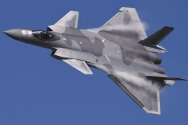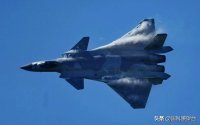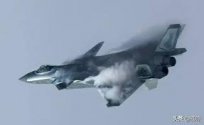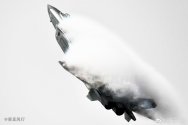We are back to comparisons again. Don't ignore mod warning guys.
You are using an out of date browser. It may not display this or other websites correctly.
You should upgrade or use an alternative browser.
You should upgrade or use an alternative browser.
J-20 5th Generation Fighter VII
- Thread starter siegecrossbow
- Start date
- Status
- Not open for further replies.
The key factor in the flight profile you’re describing is going to be wing area. Higher aspect actually induces a bit more drag than lower aspect for the same wing area because you have a wider span facing the free stream. The tradeoff of course is that the higher aspect wing should also get better lift, all else held equal. Also see my edit wrt to TVC. I think that’s also going to play a role here. But since both designs employ a lot of vortex lift with strong coupling dynamics it really is hard to say.
Yeah, a moment of confusion on my part, it is not proportionally shorter chord, it is that larger wing span can produce more lift at smaller AoA, therefore does not require the plane to pull to higher AoA hence less drag.
If I understand your post about TVC correctly, I'd concern about the torque produced by TVC needing to be counteract by control surfaces. For example if J-20 were to use TVC this way her canards will have to pitch down to counter the pitch up moment, not sure how this impact the overall picture.
Edit: Or the opposite for F-22, tail fin pitch up
Surprise, surprise WS-15 bypass ratio is envisioned to be around 0.25 on the level of F-119.F-119 in a lot of way is more like a turbojet than turbofan… the fuel consumption is not satisfied at all for j-20, especially j-20 is required for a much larger range
I therefore honestly think ws-15 will be more like a f-135 with bigger bypass ratio but not to that extreme though, still with sufficient supersonic performance yet increase bypass ratio as much as it can

Source: 顾诵芬《我国战斗机发展战略研究》
Yes. And the vortex coupling for both planes should change the lift coefficient without impact drag as much, so once you factor vortex lift into the equation comparing the optimal angle of attack for best sustained turns at a specific flight envelope becomes more difficult to assess.Yeah, a moment of confusion on my part, it is not proportionally shorter chord, it is that larger wing span can produce more lift at smaller AoA, therefore does not require the plane to pull to higher AoA hence less drag.
Well, the control surfaces are also inducing torque on the plane when they’re deflected. The steady state in a sustained turn is maintained by the balance with the drag vector and other controls that can introduce a counter torque. This is the part where your flight control optimizations get involved. But I think ultimately having TVC does help by expanding the envelope of maneuver, and especially expanding the optimal amount of forward force you can input for a given angle of attack.If I understand your post about TVC correctly, I'd concern about the torque produced by TVC needing to be counteract by control surfaces. For example if J-20 were to use TVC this way her canards will have to pitch down to counter the pitch up moment, not sure how this impact the overall picture.
Yes. And the vortex coupling for both planes should change the lift coefficient without impact drag as much, so once you factor vortex lift into the equation comparing the optimal angle of attack for best sustained turns at a specific flight envelope becomes more difficult to assess.
Well, the control surfaces are also inducing torque on the plane when they’re deflected. The steady state in a sustained turn is maintained by the balance with the drag vector and other controls that can introduce a counter torque. This is the part where your flight control optimizations get involved. But I think ultimately having TVC does help by expanding the envelope of maneuver, and especially expanding the optimal amount of forward force you can input for a given angle of attack.
My guess on J-20 is that the canards number one priority is vortex generator, control moment is secondary and can be compensated by the rest of control surfaces like flaps and ailerons. The control system will tell the canards to deflect to produce the optimal vortex for coupling. Maybe TVC can help further, I don't know.
@siegecrossbow,I was aware of this thought when I read the article. The ultimate question is what is the lift coefficients of J-20 and F-22 through the whole range of their AOA. Which we don't have for either J-20 or F-22. So the notion of "F-22 is better in sustained turn than J-20" is unfounded at least.
Here is the wind tunnel test outcome from CAC. Vertical axis is lift coefficient. Horizontal axis is AOA. Note, this is an early model of CAC 4th gen design with underside intake, otherwise same as J-20. The real figure of J-20 may differ. The model's wing AR=3, swept 45 degrees.
I will not use it as an argument but I remember reading another paper saying that J-20's lift coefficient is higher than XXXX or being the highest. I will post it if I find the paper again.
View attachment 96545
As I promised to post the source of J-20's lift coefficient value, the source is 顾诵芬《我国战斗机发展战略研究》

4th gen fighter utilize high lift, low drag, high stealthy design. According to pre-study result, the maximum lift coefficient value of fourth gen aircraft is targeted at 2, 30% higher than 3rd gen fighters.
Just note, this is probably referring to pre-prototype J-20 (with underbelly intake) discussed in the paper that I quoted in earlier posts. The final figures of J-20 may be different. However, we have heard of figure more than 2.
I am really curious about F-22 and F-16's figures.
With regards to the age of the F-22 being an disadvantage.Surely in the years since then the j-20 should have markedly more advanced sensor suite and avionics than a 20 year old design? With the caveat that the F-35 be equivalent/better than J-20 correspondingly.
Well, you take an old car, you swap out the engine, switch out the halogens for LEDs, put in new leather seats. Now you almost have a brand new car.
Tons of updates have been made to the F-22s. They are doing the same for the F-15s.
I actually think it’s the opposite. The primary vortex generators on the J-20 seem to be the LERXes, the secondary seems to be vortex coupling between the the LERXes and the dogtooth that forms from the deflection of the leading edge flaps, and then the tertiary seems to be the canards. The strongest coupling happens at higher AoA where the over-body camber that starts at the inlets generates a much more powerful low pressure field over the top of the whole fuselage, enhancing the vortices being engaged by the other vortex generators.My guess on J-20 is that the canards number one priority is vortex generator, control moment is secondary and can be compensated by the rest of control surfaces like flaps and ailerons. The control system will tell the canards to deflect to produce the optimal vortex for coupling. Maybe TVC can help further, I don't know.
The canards are probably the last vortex contributor before the over-body camber is engaged because they’re long coupled, which means that when operating by themselves their downwash effect onto the wings should be smaller or more diffuse. They’re probably most impactful in enhancing the low pressure flow field downstream when the other vortex generators are already engaged.
In fact, this arrangement is very similar to the Eurofighter’s, which also employs long coupled canards. We see that the canards on the EF are only contributing to vortex generation over the main wings once they’re coupled with strakes that sit midway between the canards and the wings. In the EF it’s actually the strakes seeding the vortex over the wings, while the canard downwash is used to enhance the vortex generated from the strakes.
The J-20’s vortex coupling dynamics actually seem to have four distinct stages, and I think studying those four stages can tell us a lot about the particulars of how the J-20 employs vortex lift for various flight maneuvers. See the attached images to get a sense of what I’m talking about.
Stage 1

Stage 2

Stage 3

Stage 4

Last edited:
I would caution that this source should be taken with a grain of salt for the purposes of performance discussions. This citation is not from a performance assessment or design development study (not directly at least), but the early program proposal from the requirements setting phase of the J-XX program, well before we got a flying prototype of the J-20 and also likely well before the final aerodynamic configuration for the J-20 was set.@siegecrossbow,
As I promised to post the source of J-20's lift coefficient value, the source is 顾诵芬《我国战斗机发展战略研究》
View attachment 96648
4th gen fighter utilize high lift, low drag, high stealthy design. According to pre-study result, the maximum lift coefficient value of fourth gen aircraft is targeted at 2, 30% higher than 3rd gen fighters.
Just note, this is probably referring to pre-prototype J-20 (with underbelly intake) discussed in the paper that I quoted in earlier posts. The final figures of J-20 may be different. However, we have heard of figure more than 2.
I am really curious about F-22 and F-16's figures.
yeah, that's why i read a lot of people was worried that after switching to WS-15, despite J-20 may able to supercruise in a higher speed, but the combat range will decreaseSurprise, surprise WS-15 bypass ratio is envisioned to be around 0.25 on the level of F-119.
View attachment 96646
Source: 顾诵芬《我国战斗机发展战略研究》
but the issue for this 顾诵芬《我国战斗机发展战略研究》, was that it was pretty old like decades old, and way before the allegedly major changes of the WS-15 design spec news just few years ago, so i'm not sure how much will these specs still hold
- Status
- Not open for further replies.
